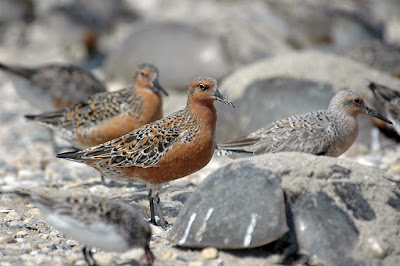 |
| Red Knot / Photo by Gregory Breese/USFWS |
- There is a significant oil spill off the coast of Santa Barbara, California, this week. The oil came from a pipeline whose owner has a long history of infractions. Here are photos of the slick and cleanup efforts. Several oiled pelicans have already been recovered, and more wildlife has been affected by the oil. The slick is heading towards Coal Oil Point Reserve, a nesting spot for threatened Western Snowy Plovers.
- New Caledonian Crows carefully place tools under their feet when they are not actively foraging.
- The American Bird Conservancy is concerned that so many wind turbines are being constructed in critical bird habitat.
- Common Eiders combine nutrients from wintering and breeding grounds when they produce eggs.
- PBS Nature aired a documentary on Greater Sage-Grouse this week.
- Griffon vultures are exposed to high concentrations of lead in their diets.
- Male Java sparrows may click their bills to accompany their songs.
- A study found that shaded coffee and cocoa plantations are better for birds than open plantations.
- Over 1,300 seabirds were found dead on a Chilean beach.
- Other animals pay attention to the alarm calls given by birds.
- Nemesis Bird: What kind of birder are you?
- Bird Ecology Study Group: Where have our Common Mynas gone?
- Backyard and Beyond: Nesting
- The City Birder: Not Such a Big Birding Day
- A study of tissue samples from dead dolphins found that many deaths since the Deepwater Horizon explosion were caused by the subsequent oil spill. Dolphins from the Gulf of Mexico showed significantly higher numbers of lesions in their lungs and adrenal glands than dead dolphins in areas not affected by the spill.
- The White House announced a National Pollinator Health Strategy (pdf) this week. To accompany that document, the USGS produced a pollinator science website.
- A gas company decided to renew its push to build a natural gas pipeline through the Pinelands, now that Christie has replaced commissioners who opposed the pipeline.
- A study suggests that half of the trees and shrubs in eastern US forests have their closest relatives in eastern Asia, and a quarter originated in North America.



